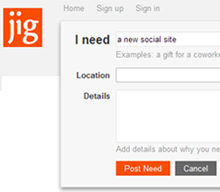Social Networking Meets Problem Solving
A new social network, called Jig, aims to be a place where users do more than just share personal news or play games. It’s a hangout where they can help solve one another’s problems.

Jig was founded by Joshua Schachter, the creator of the social bookmarking site Del.icio.us, which in the early 2000s popularized the idea of tagging, as well as the notion of publicly sharing links people found interesting. Schachter’s new site is pitched as halfway between a social network and a marketplace for advice and help, whether restaurant recommendation or diet tips.
The Jig homepage greets users with a blank, one-line text box prefaced by the words “I need.” Once a person types in their want, their entry is added to the site’s list of “recent needs” for other users to view and, if they’re feeling helpful, address.
Numerous question-and-answer sites already exist, but Jig is notable for its focus on social interaction, and because users post with the expectation of acting on the advice they receive. “What we’re trying to do is get the needs people have in front of other people that can help,” says Schachter. “We’re trying to build a social network around utility rather than just sharing stuff.”
Schachter says that he and cofounders Nick Nguyen and Paul Rademacher were inspired partly by the way many ask for advice or information from friends on Facebook and Twitter, and partly by existing question-and-answer sites like Yahoo Answers and Quora, a slick site that launched last year to great fanfare.
But Schachter argues that Facebook and Twitter aren’t well suited to solving problems, because they are built around doing so much else. At the same time, he says, Yahoo Answers and Quora are less focused on actually getting things done and have become places where people tend to discuss general topics at length. “We’re all about task completion,” says Schachter. Jig’s design is intended to encourage people to bluntly share what they want, without frills, and for others to chip in with solutions that are equally pithy.
Many of the “needs” posted on Jig may look like queries typed into a search engine like Google, but Schachter says they are better addressed by people, not algorithms.
Currently, Jig users can only post their needs, and respond to posts, but they will eventually be able to make “offers,” too, Schachter says. The details are undecided, but this could include offering household goods that are no longer needed, for example.
“Your neighbors, and other people around you, know stuff that’s useful to you, you just don’t know that,” says Schachter. To illustrate his point, Schachter describes running into a colleague just before heading to Tuscany on vacation, and discovering that this person was an expert on the region, and had valuable advice. “People really like to be helpful, and they like to be right,” he says.
Jig has been tested privately for weeks and was made available to all last Friday. So far, the site is being used mainly by the tech-savvy. Foursquare founder Dennis Crowley experimented this week with using the site to find new employees, and former venture capitalist and incoming director of MIT’s Media Lab, Joi Ito, used the site to ask for dive site recommendations while on vacation.
Schachter says it is too early to talk about how the site will make money. However, every other social network relies on advertising to make a profit. Kimberly Maul, with online advertising research firm eMarketer, says that Jig seems particularly well suited to that business model. “People are very specific about what they want and are already talking about products and services on there,” Maul says. “People post these kinds of needs on Facebook, but with Jig, it is the whole point of the network, so the density is higher.”
Maul also predicts that companies will be keen to create their own profiles on the site. It has become standard for companies to have a presence on Facebook and Twitter, and when Google launched its own social network this year, companies clamored to create accounts for their brands. Schachter says he hasn’t yet decided how corporate accounts will figure in Jig’s future.
Maul adds that for Jig to successfully serve individual and corporate users, it will have to attract more users, and carve out a sustainable niche between existing social networks. “I’m curious to see if they get a good community outside just the early adopters,” she says.
Keep Reading
Most Popular
Large language models can do jaw-dropping things. But nobody knows exactly why.
And that's a problem. Figuring it out is one of the biggest scientific puzzles of our time and a crucial step towards controlling more powerful future models.
How scientists traced a mysterious covid case back to six toilets
When wastewater surveillance turns into a hunt for a single infected individual, the ethics get tricky.
The problem with plug-in hybrids? Their drivers.
Plug-in hybrids are often sold as a transition to EVs, but new data from Europe shows we’re still underestimating the emissions they produce.
Stay connected
Get the latest updates from
MIT Technology Review
Discover special offers, top stories, upcoming events, and more.